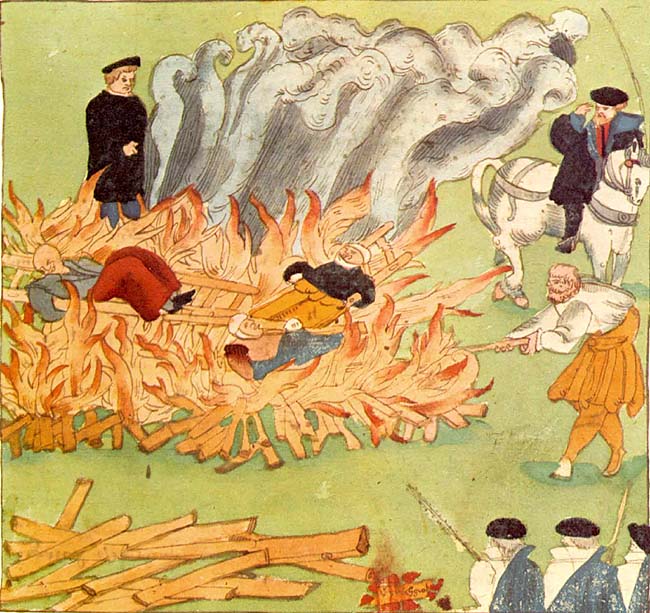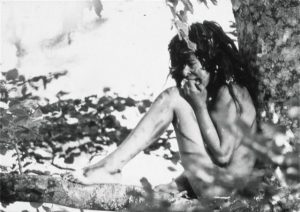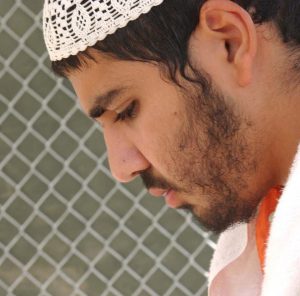In today’s world, when someone thinks of a witch, they normally picture one of a few things: the infamous Wicked Witch of the West that was out to get our beloved Dorothy; Bette Midler’s crazy looking character in Hocus Pocus; or a sparkly, purple and black ‘Party City’ outfit that young girls wear as a sort of ‘right of passage’ Halloween costume. Some may even think back to their high school history lessons about the Salem Witch Trials during the late 1600’s in colonial America. These images, however, are drastically different from those a 15th-century European would have pictured. They would have conjured up the image of a woman who wasn’t religious, who went against social norms, who had supernatural powers, and who therefore was most definitely associated with the devil.1 These Europeans would have pictured the faces of the many women accused and killed in the witch hunts of the time that were in large part driven by skewed societal perceptions, religious fears, and hysteria.
The witch hunts in Europe occurred on a much larger scale than those that took place in Salem Village. Records suggest that the hunts began as early as the 14th century and went on until around 1650, gaining the most momentum during the late 15th century. In total, the executions of supposed witches by Europeans numbered between 200,000 and 500,000, with 85% or more of those accused of and executed for witchcraft being women.2 Additionally, around 95% were specifically poor, old, single, or widowed women.3 Based on social perceptions of the time, these numbers, quite frankly, are not surprising. It is said that “heresy evidence, a major element during the dominance of the European witch craze, was that Satan recruited servants, mostly women, by signing a pact with them and turned them into his sexual subordinates.”4 It was understood by society members that these women who made such a pact with the devil were “female witches [given] the opportunity to commit evil deeds,” and that as a result of their pact and evil-doings, “[their] souls…belonged to the devil, and these women would serve in hell upon their death.”5 Society members also understood that single, elderly, poor, and/or widowed women were outcasts, and in some cases were even thought to be living sinful lives. The perception of all women as impressionable, and the perception of certain types of women who were generally unaccepted, contributed largely to the witch craze in Europe.
Perhaps the biggest factor that fueled the witch hunts of the time, however, stemmed from the religious conflicts of the age. Fifteenth-century Europeans were extremely devout Christians, and often viewed anything different as a threat to their religion. A common belief among many was that certain people possessed supernatural powers, and at the end of the fifteenth century, pronouncements from the era’s theologians began to circulate. They suggested that those who possessed diabolical powers were witches and drew their abilities straight from the devil himself.6 These beliefs were intricate, and included details about supposed witches flying to foreign places on broomsticks to attend a witch’s Sabbath, worship the devil, create special potions, and even engage in sexual relations with the devil.7 As a result of these beliefs, assumptions and rumors began to spread, mostly whenever something unexpected or inexplicable happened, that the event had been caused by a witch. These bad events ranged from crop failures to a woman’s inability to conceive.8 Given this extreme characterization, it becomes evident that Europeans of the time took witches, their powers, and their relationships with the devil very seriously. But why? What led to the widespread fear, accusations, and killings of witches in Europe?

As mentioned earlier, Europeans did not take their religious beliefs lightly, and any threats to Christianity were treated with utmost scrutiny. Additionally, because the religious wars between Catholics and Protestants occurred during the same time at which the witch hunts peaked, nothing was more concerning to a European Christian than someone who threatened their form of Christianity. British historian Norman Cohn summed up the need for Europeans to find and kill witches as “the need to create a scapegoat for an unacknowledged hostility to Christianity.”9 In this context, it may be understood that Europeans of the time were influenced–probably by the religious wars that were happening in their homelands at the time–into believing that these conflicts were a result of witches and their relationships with the devil. Other common religious beliefs that helped to fuel the fear and persecution of supposed witches included the “religious-driven conception of the relationship between demonology and witchcraft,” which elicited a belief “that the world served as a battlefield upon which an ongoing struggle between Satan and God was portrayed.”10 In a society where such a common–and detailed–belief regarding the continuous war between God and the devil was prevalent, it makes sense that rumors of witches would cause fear enough to spark the type of witch hunts that took place in Europe between the fourteenth and sixteenth centuries. Furthermore, the witch hunts took place during the heat of both the Protestant Reformation and the Catholic Counter-Reformation; therefore, those who followed the Protestant or Catholic faiths were primary targets.11
It is said that Protestant authorities who searched for and prosecuted witches acted more harshly than did authorities of the infamous Spanish Inquisition.12 Catholic witch hunting leaders also went out of their way to condemn witches by publishing the Malleus Maleficarum in 1487; this document made “demonology a severe offense punishable by religious and subsequently secular authorities.”13
For these reasons, the witch hunts were widespread throughout Europe and lasted for over 200 years. Although widespread across all of continental Europe, they were generally concentrated in areas where Catholics and Protestants lived in close proximity to each other. In most cases between the fourteenth and sixteenth centuries, the hunts occurred in waves. Catholic lands in Germany were hit with a wave in the 1560s and 1570s, and again in the 1610s and 1620s; large waves occurred simultaneously throughout small communities within the Holy Roman Empire.14 Protestant lands affected the most were Scotland and the Swiss territory of Vaud, conducting nearly 3,000 executions combined.15 Those accused of witchcraft were made to stand trial and were, more times than not, found guilty and executed by hanging or burning.16 In some cases, accused witches were even tortured and forced into making confessions.17

As with other targeted mass killings throughout history, it can be noted that the European witch hunts that took place between the fourteenth and seventeenth centuries were largely influenced by several social and political factors. Most evident are the religious views, opinions, and hostilities that existed among European communities and peoples at the time. Furthermore, the fact that a majority of those witches accused and executed were women who were viewed as being outside societal norms suggests that they were persecuted for reasons of social standards and class influence. Overall, this dark period in European history was clouded with judgement, fear, and religion-fueled wars that–in one way or another–led to the execution of hundreds and thousands of supposed witches. Whether or not the executed were actually witches, we may never know. One thing that is almost certain, however, is that the lesson of redefining moral boundaries that should have been learned from the European witch hunts, instead went unnoticed, allowing similar persecutions to occur in the New World less than fifty years later.18
- Jerry H. Bentley, Herbert F. Ziegler, and Heather E. Streets-Salter, Traditions & Encounters: A Brief Global History from 1500 to the Present, Fourth, Vol. 2 (New York: McGraw-Hill Education, 2016), 376. ↵
- Nachman Ben-Yehuda, “The European Witch Craze of the 14th to 17th Centuries: A Sociologist’s Perspective,” American Journal of Sociology 86, no. 1 (1980): 1. ↵
- Jerry H. Bentley, Herbert F. Ziegler, and Heather E. Streets-Salter, Traditions & Encounters: A Brief Global History from 1500 to the Present, Fourth, Vol. 2 (New York: McGraw-Hill Education, 2016), 376. ↵
- Nachman Ben-Yehuda, “Witches,” in Encyclopedia of Death & the Human Experience, edited by Clifton D. Bryant and Dennis L. Peck, Vol. 2 (Thousand Oaks, CA: SAGE Publications, 2009), 996. ↵
- Nachman Ben-Yehuda, “Witches,” in Encyclopedia of Death & the Human Experience, edited by Clifton D. Bryant and Dennis L. Peck, Vol. 2, (Thousand Oaks, CA: SAGE Publications, 2009), 996. ↵
- Jerry H. Bentley, Herbert F. Ziegler, and Heather E. Streets-Salter, Traditions & Encounters: A Brief Global History from 1500 to the Present, Fourth, Vol. 2 (New York: McGraw-Hill Education, 2016), 376. ↵
- Jerry H. Bentley, Herbert F. Ziegler, and Heather E. Streets-Salter, Traditions & Encounters: A Brief Global History from 1500 to the Present, Fourth, Vol. 2 (New York: McGraw-Hill Education, 2016), 376. ↵
- Jerry H. Bentley, Herbert F. Ziegler, and Heather E. Streets-Salter, Traditions & Encounters: A Brief Global History from 1500 to the Present, Fourth, Vol. 2 (New York: McGraw-Hill Education, 2016), 376. ↵
- Madeleine Jeay, “French ‘Witches’ (14th–16th Centuries),” in Women in World History: A Biographical Encyclopedia, ed., Anne Commire (Detroit: Yorkin Publications, 2002), 774. ↵
- Nachman Ben-Yehuda, “Witches,” in Encyclopedia of Death & the Human Experience, eds. Clifton D. Bryant and Dennis L. Peck, Vol. 2 (Thousand Oaks, CA: SAGE Publications, 2009), 996. ↵
- Alfred J. Andrea, and Carolyn Neel, eds., “Witch-Hunting in Western Europe: Trial by Ordeal–Witch-Hunts and Methods of Extracting Confessions,” World History Encyclopedia (Santa Barabara, CA: ABC-CLIO, 2011), 880. ↵
- Alfred J. Andrea, and Carolyn Neel, eds., “Witch-Hunting in Western Europe: Trial by Ordeal–Witch-Hunts and Methods of Extracting Confessions,” World History Encyclopedia (Santa Barabara, CA: ABC-CLIO, 2011), 880. ↵
- Alfred J. Andrea and Carolyn Neel, eds., “Witch-Hunting in Western Europe: Trial by Ordeal–Witch-Hunts and Methods of Extracting Confessions,” World History Encyclopedia (Santa Barabara, CA: ABC-CLIO, 2011), 880. ↵
- H. C. Erik Midelfort, “Witchcraft,” in Europe, 1450 to 1789: Encyclopedia of the Early Modern World, ed. Jonathan Dewald, Vol. 6 (New York: Charles Scribner’s Sons, 2004), 223. ↵
- H. C. Erik Midelfort, “Witchcraft,” in Europe, 1450 to 1789: Encyclopedia of the Early Modern World, ed. Jonathan Dewald, Vol. 6 (New York: Charles Scribner’s Sons, 2004), 223. ↵
- Jerry H. Bentley, Herbert F. Ziegler, and Heather E. Streets-Salter, Traditions & Encounters: A Brief Global History from 1500 to the Present, Fourth, Vol. 2 (New York: McGraw-Hill Education, 2016), 376. ↵
- Madeleine Jeay, “French ‘Witches’ (14th–16th Centuries),” in Women in World History: A Biographical Encyclopedia ,ed. Anne Commire (Detroit: Yorkin Publications, 2002), 774-775. ↵
- Nachman Ben-Yehuda, “The European Witch Craze of the 14th to 17th Centuries: A Sociologist’s Perspective,” American Journal of Sociology 86, no. 1 (1980): 24-25. ↵



138 comments
Mia Hernandez
I find stories like this one very interesting to read so it was no surprise to me that I enjoyed this article. Looking at the story from the perspective of its time period, it seems relatively odd considering the norms at the time but not incomprehensible. But when compared to how we see and deal things in todays society, the witch hunts are now considered something crazy.
Sara Guerrero
The witch hunts was definitely a craze and panic that went on with Europeans, but their reasoning for who was a witch and how they proved it was even more ridiculous. I agree that women were accussed of being a witch if they didn’t follow the norms of society and because of standards. Witches probably existed, but still innocent people didn’t have to die due to religious and societal conflicts. Great article and I like how you brought another perspective of the witch hunt.
Arsema Abera
I always have thought witches were the coolest supernatural voodoo things to walk on earth I mean white witches that did good magic and all that and anybody that hasn’t seen Harry potter thinks otherwise. However, the injustice and prejudice seen at that time isn’t fair, just because a woman has no man protecting her is automatically assumed as a witch just sounds thoughtless furthermore these women had to endure horrible punishment if they were suspected of being witches like being thrown into the river tied and if they were to come out alive they were seen as witches and if they drown, which many did, they just passed the matter by well oh well! she wasn’t a witch.
Giselle Garcia
Comparing what society perceives witches today is very different to how Europeans saw them during the witch hunt. Europeans usually accused single, poor, widowed women to be witches, since they were outside of societal norms. It’s crazy that just because they were outcasts, the European Christians thought they were leading sinful lives and even to the extreme of being a witch. An interesting fact that I was unaware of brought up in the article was that the prosecutions were more harsh than the Spanish Inquisition.
Aaron Sandoval
I liked how you brought attention to the fact that witch hunts were much greater and more common than the Salem trials, in the U.S. we tend to overlook that witchcraft trials had been going on for centuries before the events at Salem and I like how that is your focus. Your use of detail and the reasoning for why the witch hunts began is very good, as well as your incorporation of the books that became the foundation for proving witchcraft.
Lesley Martinez
The perceptions of witches in the introduction is very accurate. This article does a great job of demonstrating that witches were seen differently during the fifteenth century. It’s interesting to read that witches were believed to have supernatural powers that were linked to the devil. Also, it’s outrageous to know that they were prosecuted more harshly than the authorities of the Spanish Inquisition. This was a great article and raises a great point that most of the “witches” in the European witch hunt were women and may be connected to social standards and class influence. Great article!
Zachary Kobs
What an interesting read, it is crazy to think that is what society used to classify as normal. If we compare that to where we are today we are a lot more innocent until proven guilty and do not just go on the word of the few or the many. However, it is not uncommon for our modern society to see someone different from them or society’s norms and try to outcast them.
Melissa Garza
This was so interesting to read about because it gives a good insight on the views people had in the past. It shows how much they really valued societal norms and how much they abided by them. Just because they were poor, old, single, or widowed they would automatically think something was wrong with them and obviously they associated it with religious myths because it was so predominant in older times.
Antonio Holverstott
These witch trials in Europe and the United States violated both religious principles and standards of rational thought. They judged the moral character of others based on appearances such as being a lonely elderly lady or young girl, rather than the content of their character found within their heart. Also, they used these stereotypes to find these persons guilty before any investigation was necessary to seek the truth of the matter. In addition, the matter in which they ran these trials violated human decency by causing significant bodily harm to the accused.
Samuel Vega
Yes, my first thought of witches, is the Salem Witch Trials. I was unfamiliar with the fear that Catholics and Protestants had regarding witches in the 15th Century. The article gives me understanding of why one who believed in Christianity could act so violently. The fear of the unknown drove senseless death and hatred. The article explains how societal and political pressures of the day were foundational to the hatred of those who were assumed to be witches.